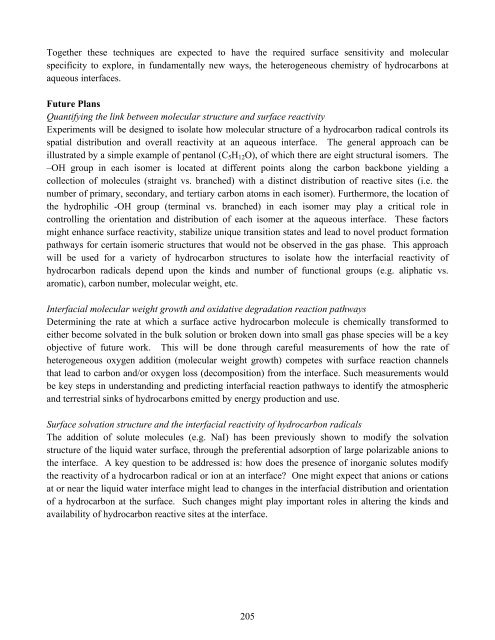Eighth Condensed Phase and Interfacial Molecular Science (CPIMS)
Eighth Condensed Phase and Interfacial Molecular Science (CPIMS)
Eighth Condensed Phase and Interfacial Molecular Science (CPIMS)
You also want an ePaper? Increase the reach of your titles
YUMPU automatically turns print PDFs into web optimized ePapers that Google loves.
Together these techniques are expected to have the required surface sensitivity <strong>and</strong> molecular<br />
specificity to explore, in fundamentally new ways, the heterogeneous chemistry of hydrocarbons at<br />
aqueous interfaces.<br />
Future Plans<br />
Quantifying the link between molecular structure <strong>and</strong> surface reactivity<br />
Experiments will be designed to isolate how molecular structure of a hydrocarbon radical controls its<br />
spatial distribution <strong>and</strong> overall reactivity at an aqueous interface. The general approach can be<br />
illustrated by a simple example of pentanol (C5H12O), of which there are eight structural isomers. The<br />
–OH group in each isomer is located at different points along the carbon backbone yielding a<br />
collection of molecules (straight vs. branched) with a distinct distribution of reactive sites (i.e. the<br />
number of primary, secondary, <strong>and</strong> tertiary carbon atoms in each isomer). Furthermore, the location of<br />
the hydrophilic -OH group (terminal vs. branched) in each isomer may play a critical role in<br />
controlling the orientation <strong>and</strong> distribution of each isomer at the aqueous interface. These factors<br />
might enhance surface reactivity, stabilize unique transition states <strong>and</strong> lead to novel product formation<br />
pathways for certain isomeric structures that would not be observed in the gas phase. This approach<br />
will be used for a variety of hydrocarbon structures to isolate how the interfacial reactivity of<br />
hydrocarbon radicals depend upon the kinds <strong>and</strong> number of functional groups (e.g. aliphatic vs.<br />
aromatic), carbon number, molecular weight, etc.<br />
<strong>Interfacial</strong> molecular weight growth <strong>and</strong> oxidative degradation reaction pathways<br />
Determining the rate at which a surface active hydrocarbon molecule is chemically transformed to<br />
either become solvated in the bulk solution or broken down into small gas phase species will be a key<br />
objective of future work. This will be done through careful measurements of how the rate of<br />
heterogeneous oxygen addition (molecular weight growth) competes with surface reaction channels<br />
that lead to carbon <strong>and</strong>/or oxygen loss (decomposition) from the interface. Such measurements would<br />
be key steps in underst<strong>and</strong>ing <strong>and</strong> predicting interfacial reaction pathways to identify the atmospheric<br />
<strong>and</strong> terrestrial sinks of hydrocarbons emitted by energy production <strong>and</strong> use.<br />
Surface solvation structure <strong>and</strong> the interfacial reactivity of hydrocarbon radicals<br />
The addition of solute molecules (e.g. NaI) has been previously shown to modify the solvation<br />
structure of the liquid water surface, through the preferential adsorption of large polarizable anions to<br />
the interface. A key question to be addressed is: how does the presence of inorganic solutes modify<br />
the reactivity of a hydrocarbon radical or ion at an interface? One might expect that anions or cations<br />
at or near the liquid water interface might lead to changes in the interfacial distribution <strong>and</strong> orientation<br />
of a hydrocarbon at the surface. Such changes might play important roles in altering the kinds <strong>and</strong><br />
availability of hydrocarbon reactive sites at the interface.<br />
205
















